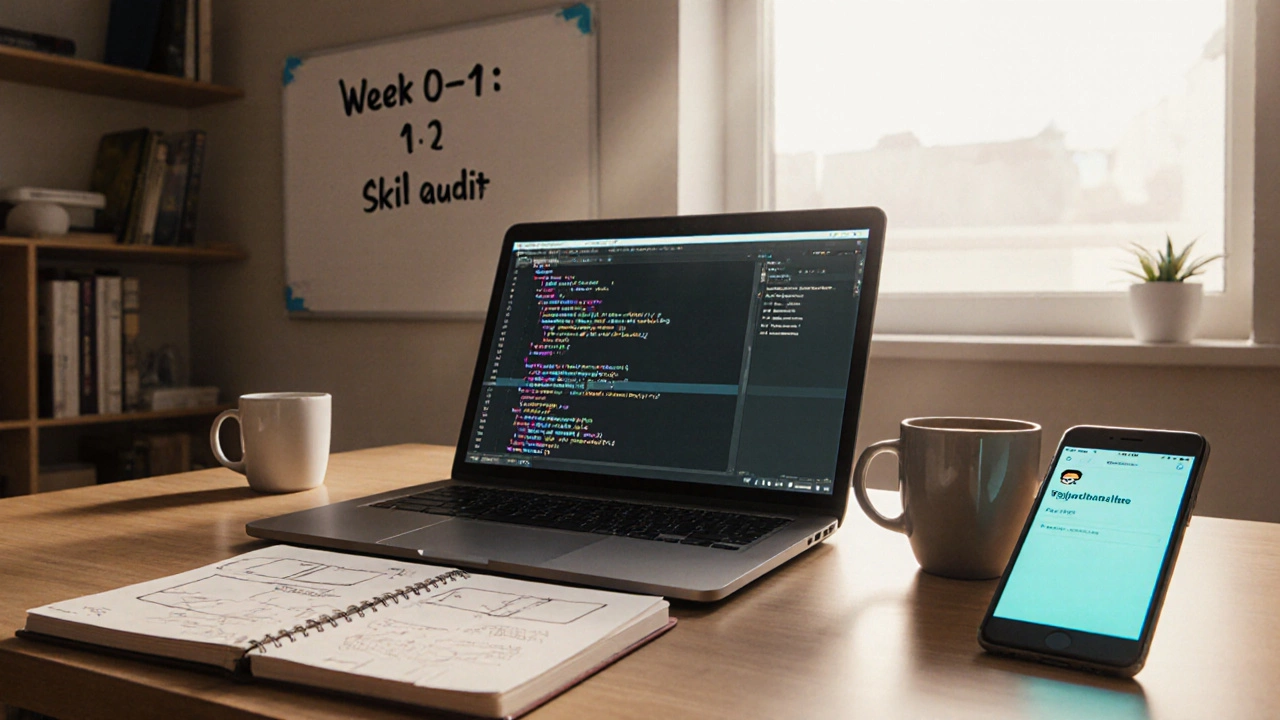First Payment Timeline Calculator
Estimate Your First Payment Timeline
Your Current Status
How You'll Find Work
Estimated Timeline
Key Influencing Factors
Quick Takeaways
- Most developers land their first paid job within 1‑3 months of actively marketing.
- Having a solid portfolio cuts the timeline in half.
- Platform gigs (Upwork, Fiverr) can bring cash in weeks, but rates are lower.
- Direct client work usually starts paying after 30‑45 days of invoicing.
- Diversifying income (maintenance contracts, digital products) speeds up cash flow.
If you’re wondering whether you can quit the 9‑to‑5 and start pulling in a steady paycheck, the answer is: it’s doable, but the speed depends on a handful of practical steps. Below we break down the real‑world timeline, the factors that move the needle, and the exact actions you can take today to start seeing money in the bank.
Freelance Web Developer is a self‑employed professional who builds websites for clients on a contract basis. The journey from zero to first payment is less about luck and more about setting up the right infrastructure, showcasing the right work, and reaching out to the right people.
What a Freelance Web Developer Actually Does
In plain terms, a Web Development process involves turning designs into functional websites using languages like HTML, CSS, and JavaScript. You might specialize in front‑end, back‑end, or full‑stack, but the core promise to a client is: "I’ll deliver a site that works, looks good, and meets your business goals."
Typical Timeline to Your First Paid Project
- Week 0‑1: Skill audit & gear‑up - Make sure you’re comfortable with HTML, CSS, JavaScript, and at least one back‑end language (Node.js, PHP, Python). Having a local development environment (VS Code + Live Server) is essential.
- Week 1‑2: Build a showcase portfolio - Create 2‑3 polished projects (personal site, a mock e‑commerce page, a small blog). Host them on GitHub a code‑hosting platform that lets you share repositories publicly and link them to a live URL.
- Week 2‑3: Set up payment & invoicing tools - Open a PayPal business account, connect Stripe, and draft a simple invoice template (include your name, services, hourly rate, payment terms).
- Week 3‑4: Sign up for a freelance marketplace - Create a profile on Upwork a platform that matches freelancers with short‑term client projects. Fill out every section, upload your portfolio, and write a concise headline that mentions "freelance web developer earnings".
- Week 4‑6: Pitch and land a small gig - Apply to 10‑15 entry‑level jobs each day. Focus on projects that require a single page or a quick fix - these close faster and pay within 1‑2 weeks of acceptance.
- Week 6‑8: Deliver, invoice, and get paid - Complete the work, send a professional invoice, and follow up politely. Most platforms release the funds after a 14‑day hold.
Following this sprint, many freelancers report their first real cash flow around the 8‑week mark. If you already have a network or referrals, the timeline can shrink to 4‑5 weeks.
Key Factors That Accelerate or Slow Down Earnings
- Portfolio quality: High‑resolution screenshots, live demo links, and clear case studies convince clients faster.
- Niche focus: Specializing in WordPress, Shopify, or React reduces competition and lets you charge premium rates.
- Pricing strategy: Starting at a low hourly rate (
$20‑$30/hr) brings jobs quickly but drags out the path to sustainable income. - Geographic expectations: Clients from North America and Europe typically pay 2‑3× more than those from lower‑cost regions.
- Payment terms: Requiring 50% upfront shortens the cash‑flow gap.
- Marketing consistency: Posting weekly on LinkedIn, sharing code snippets on GitHub, and answering questions on Stack Overflow builds credibility.
Income Streams and When They Usually Kick In
| Revenue Stream | Average Time to First Payment | Typical Rate (USD/hr) | Effort to Start |
|---|---|---|---|
| Marketplace gigs (Upwork, Fiverr) | 1‑2 weeks after contract | $20‑$35 | Low - just create a profile |
| Direct client projects (referrals, cold outreach) | 3‑6 weeks (negotiation + first invoice) | $40‑$80 | Medium - portfolio & outreach needed |
| Maintenance retainer | 2‑3 months (after initial build) | $30‑$50 per month | Medium - need a satisfied client first |
| Digital product (templates, plugins) | 3‑6 months (product creation + marketing) | Variable - $10‑$100 per sale | High - develop and list on marketplaces |
| Online teaching (Udemy, Skillshare) | 4‑8 months (course creation + platform review) | $0.10‑$0.30 per view | High - create video lessons |
Fast‑Track Strategies to Land Your First Paying Client
- Leverage existing contacts - ask former colleagues or friends if they need a site.
- Offer a free audit for a local small business; follow up with a proposal.
- Write a short case study on a personal project and post it to LinkedIn; include a CTA like "Open to new web projects".
- Join niche Slack or Discord communities (e.g., "WordPress Developers"), answer questions, and subtly share your portfolio link.
- Run a limited‑time discount (e.g., 20% off the first project) but make the offer time‑bound to encourage urgency.
Common Pitfalls and How to Dodge Them
- Undervaluing your work. Set a minimum hourly rate and stick to it; low rates attract price‑shoppers, not serious clients.
- Skipping contracts. Even a one‑page agreement protects both sides and clarifies payment terms.
- Not asking for deposits. A 30‑50% upfront deposit reduces the risk of non‑payment.
- Over‑promising. Be realistic about timelines; missed deadlines hurt reputation.
- Neglecting follow‑up. After delivering, ask for a testimonial and a referral - it fuels the next gig.
Launch Checklist: Things to Have Ready Before You Start Pitching
- Professional email address (e.g.,
[email protected]). - Up‑to‑date Portfolio a collection of live project links, screenshots, and brief problem‑solution statements on a personal domain.
- Standard Invoice a template that includes your rates, payment terms, and tax information saved as PDF.
- Accounts on PayPal, Stripe, or TransferWise for international payouts.
- One‑page contract template covering scope, milestones, and termination clauses.
- Profiles on at least two freelance platforms (e.g., Upwork and Fiverr).
Putting It All Together: Your First 90‑Day Roadmap
- Days 1‑14: Finalize portfolio, set up payment tools, create Upwork/Fiverr profiles.
- Days 15‑30: Apply to 10‑15 jobs daily, engage in niche communities, offer free audits.
- Days 31‑45: Secure first contract, collect deposit, deliver work, invoice, and get paid.
- Days 46‑60: Request testimonial, add it to portfolio, start outreach for a second client.
- Days 61‑90: Pitch a maintenance retainer to the first client, explore a small digital product (e.g., a WordPress starter theme).
Follow this cadence and you’ll move from zero to a steady cash flow in roughly three months, with the potential to double your income once you add recurring services.
How soon can I expect my first payment?
If you land a gig on a freelance marketplace and complete the work within a week, the platform usually releases the funds after a 14‑day hold. That means you could see cash in hand in as little as 2‑3 weeks from the moment you accept the job.
Should I charge hourly or per project?
Both work, but beginners often start with hourly rates to avoid under‑pricing on unknown scope. As you gain experience, switch to fixed‑price packages for better predictability and higher profit margins.
Do I need a company registration in the UK?
In the UK you can operate as a sole trader without formal registration, but registering as a limited company offers tax benefits and credibility. Many freelancers start as sole traders and switch once revenue exceeds £10,000 per year.
What tools help me invoice clients quickly?
Tools like Wave, FreshBooks, or even a customised Google Docs template work well. Choose one that integrates with your PayPal or Stripe account so you can embed a payment link directly in the invoice.
Can I earn a full‑time income from freelancing?
Absolutely. Once you secure a mix of direct contracts, retainer work, and possibly a side product, many developers earn £3,000‑£5,000+ per month. Consistency comes from repeat clients and diversified income streams.





